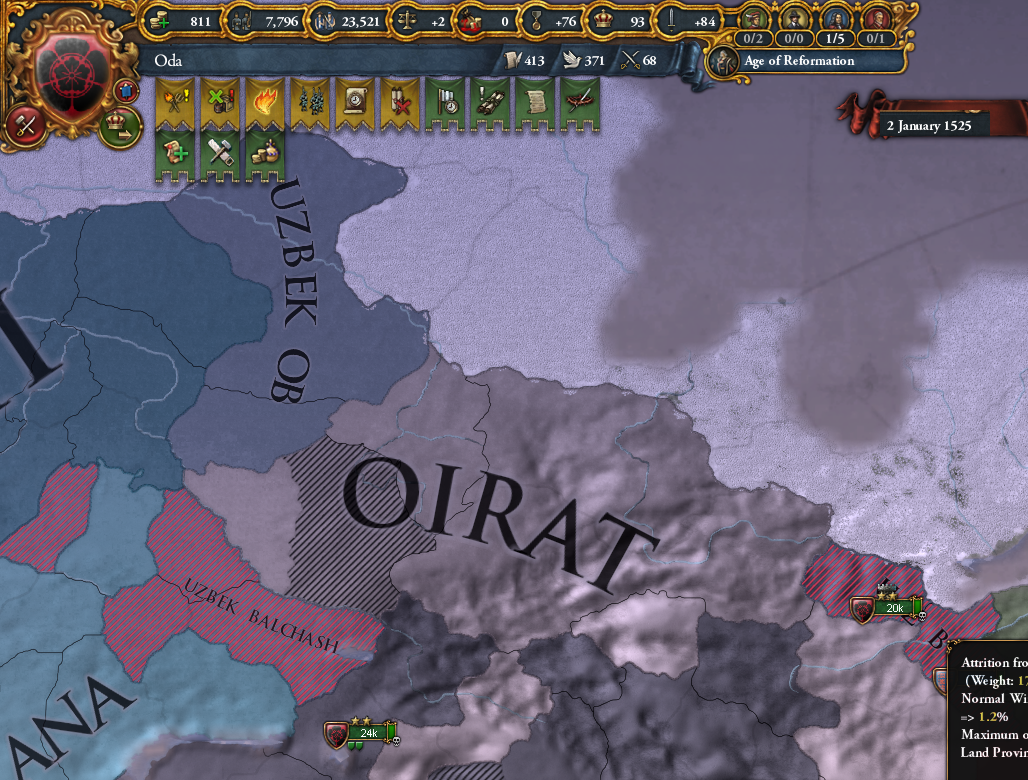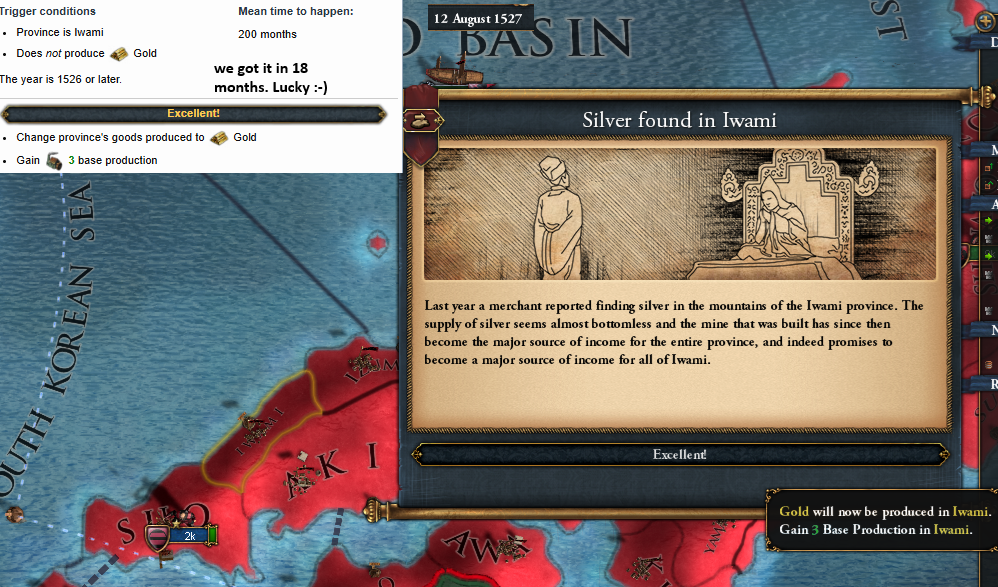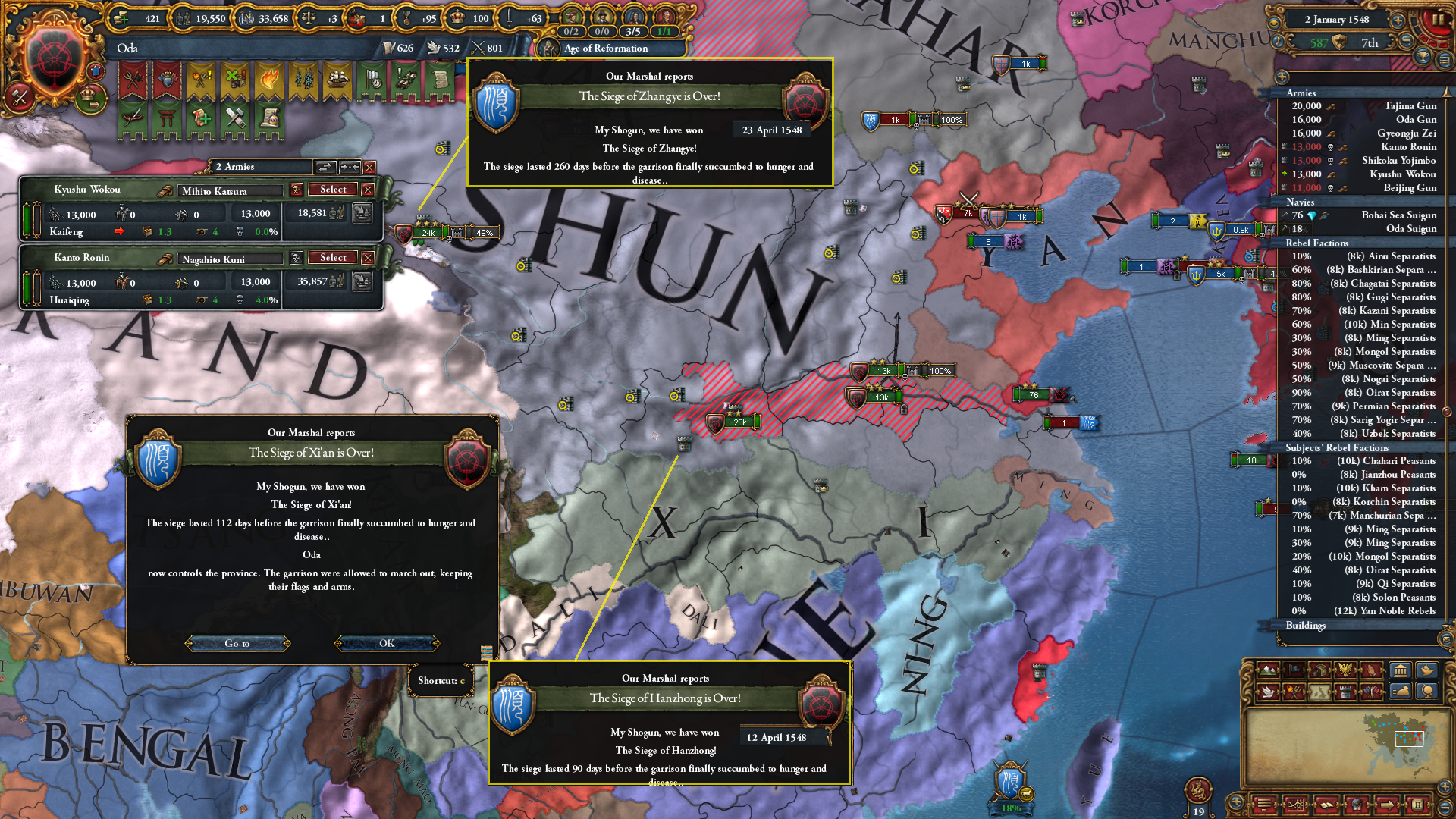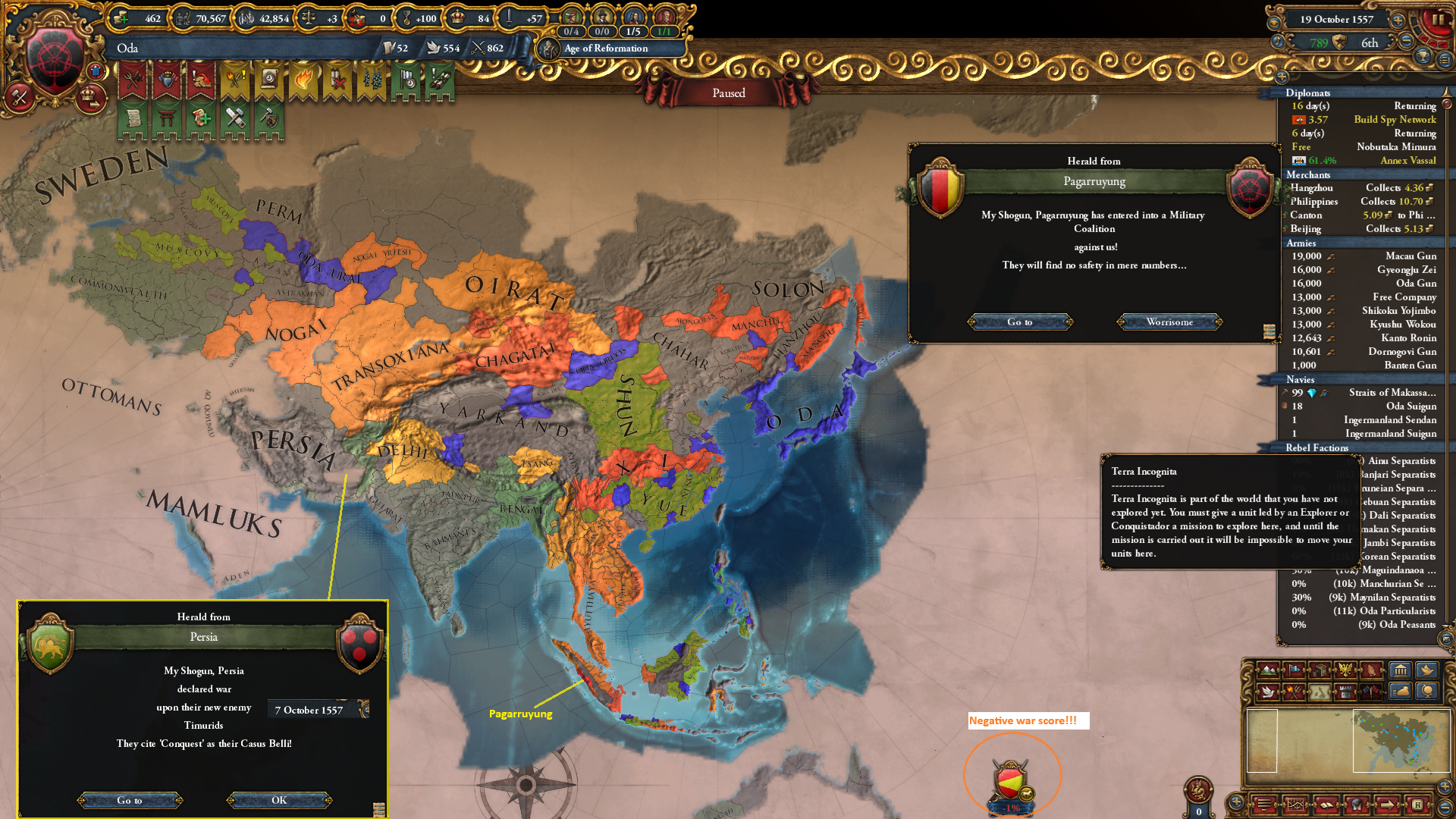Chapter 10: From Sea to Shining Sea ( 1540-1550)
We left the last chapter at war with Shun and Korea. The fighting was going well but war exhaustion was taking its toll in Oda and diplomatic power had to be spent to address that
And further west, the Shogun followed with interest the war between his rival the Ottomans and their nemesis the Mamluks.
It appeared that the Ottomans were planning on turning the Mamluks into their vassals, which would for sure make them a more formidable enemy.
Meanwhile, Oda was slowly turning her Ural provinces into cores. But we stress the
*slowly* part here.
At that rate, the most westward province would not be cored till 1556, which meant continued over-extension strain on Oda's government.
In contrast to the slow coring progress, Oda made good progress on her national ideas, adopting the last mercenary idea in July 1540, giving her mercenary companies more manpower ( something they needed sorely ) . And this immediately allowed the Odan military to improve the discipline of the mercenaries [mercenary finisher] , to increase the total manpower pool [7th national idea], to increase the fire skills of future generals [ national ambition], and to adopt the Client State Act allowing creation of client states and increasing the vassal contribution to force limits [Influence-Mercenary policy]. Yoshinobu considered these multiple bonuses well worth the price of a slight delay in the adoption of the next military technology.
As to the war with SHun and Korea, a big milestone was reached in October 1540 when the Korean capital Hanseong fell, and the Japanese troops encountered the ancient Tripitaka Koreana
[don't know why this event did not trigger in the previous war].
The Shogun was asked what to do with this ancient document collection, and some urged him to burn it. But he wisely decided to bring it back to Kyoto where he hoped it would help with the adoption of new institutions and give more splendor to his government. He followed that success with a peace treaty forcing the Koreans to cede much of their remaining land, reducing the once populous nation to a rump state
The annexation of North Korea significantly exacerbated Oda's over-extension, which was still dealing with the uncored provinces in the Urals.
The Shogun worried that rebellions would start to pop everywhere as a result, which would put more strain on Oda's dwindling manpower reserves. SO he decided to remedy this problem quickly by giving his westernmost Ural provinces to a new vassal ( Astrakhan) . And that meant he had to make peace in a hurry with Shun. And in that effort, he made a minor mistake when he signed a separate peace with Shun's ally Ning, taking money and reparations, instead of simply negotiating with Shun who was willing to end the war right then.
The peace with Ning gave up the only provinces that Oda still occupied in the war, and so Oda had to occupy a few more enemy provinces to convince Shun to sign a white, a process that took a few months.
The good thing about a white peace was the short truce, which meant Oda would get to attack Shun a second time this decade . And now with Oda at peace, the provinces in the Urals west of the Bashgird gold mine were given to Astrakhan, solving Oda's over-extension problem.
After that, Oda spent some time at peace in order to improve relations with the original Japanese Daimyos, and then began the simultaneous annexations of So, Ashikaga and Yamana ( they had to be simultaneous, otherwise as soon as the first one completed, the relation hit with the others would prevent starting the next annexation). THat lull in war was apparently enough to give Jianzhou the chance to attack their fellow Daimyo Orochoni. And as far as we know, that was the first instance of an Odan vassal declaring Sengoku on another one.
The Shogun immediately reacted by ordering the Jianzhou leader to commit Seppuku. That did not stop the war, but it did improve the Oda's governmental resources. This was followed by the adoption of a Religious Wars as an ability fitting this age of religious turmoil.
Oda chose that because she was surrounded on all sides by non-Shinto nations, and this would make annexation of future land easier. And the heathen land that Oda coveted was that of Orthodox Muscovy
This was a good time for Oda to attack the Muscovites. They had no allies, and were militarily backwards . And Oda wanted to take advantage of the fact that Muscovy's Christian neighbors had no knowledge of Oda and could not join any coalitions against her if Oda annexed too much land.
The war was managed by the SHogun carefully. The distances to Russia were vast and reinforcing with a fresh army from the home provinces would be difficult , so Oda could not afford to lose any battles . But before we detail that war, we will note an important international event
The Ottomans decided against turning the Mamluks into their vassal, and instead opted for annexing more land. The Shogun, who was obviously very fond of having loyal vassals, wondered why the Turkish Sultan would chose such a course. But it certainly was the better choice for Oda
Now back to the war in Russia.
The first major event was the fall of the fort of Kazan to the Odan siege army ( which was backed up by two mercenary companies) . The siege was made shorter thanks to skilled generalship and plenty of artillery. The armies immediately moved onto the enemy capital Moskva, sticking together in case of enemy counter attack. THe main Odan force took Moskva after 141 days while small Daimyo armies started arriving and occupying unfortified provinces in the Perm area. Meanwhile the Russians were counter-sieging the fort at Kazan.

The Odan army hurried back to relieve the garrison of Kazan. But an unlucky breach had the city fall to the RUssians just before help arrived [fell at 21%]. The Muscovites then moved on from Kazan to wipe out the small Daimyo armies to the East. That unlucky siege probably lengthened the war by a whole year as it allowed the Musvoite main army to escape. But the outcome of the war was never in doubt. Oda went back to sieging Russian cities, taking Novgorod in August 1544, while the Muscovites wasted their time chasing the Daimyos in the Urals.
And after the fall of Novgorod, Odan armies moved on to Luki, taking that fort and exterminating the Russian force hiding behind it in Ostrov.
A few months later, peace was concluded
In the peace, Oda took land all the way to the Baltic and White Sea, making the Odan Empire stretch from the Pacific to the Atlantic. She also took land just north of her Ottoman rival to cut them off from further expansion North into the Russian region . Almost all the new land was given to the new Daimyos of Novgorod and Nizhni Novgorod. The Shogun planned to annex those vasals - particularly Novgorod- as soon as possible, so that Oda would have her own port [and cores] in Europe. Amazingly, this was all done with the neighboring Swedes and Poles not really knowing who was the new Asian power absorbing all that land next door.
With his western borders expanded, the Shogun turned his attention South, towards Persia and India. And here he eschewed the methods of war, and chose the diplomatic route. First an alliance was concluded with Persia ( although they are an empire that Katsunaga swore to kill, they can be a useful ally for a while) .
Persia was Oda's first ally since the assumption of the Shogunate many moons ago . Persia was chosen as a counter-weight to the Ottomans and potential helper in any expansion in Central Asia. The Shogun then assessed the situation in India. There was no strategic imperative for Oda to invade INdia. But there was concern that a successful nation there would one day become a so-called Empire. And in particular the nation of Bahmanis seemed to be the most concerning .
Bahmanis was allied to Delhi and Bengal, both strong nations at the other "corners" of the Indian "triangle" . Neigboring Bahmanis were the weaker nations of Vijayanagar , Jaunpur, and Gujarat. Without intervention by Oda, Bahmanis was very likely to unify Southern India and become the Deccan Empire. To prevent that , Oda allied bahmani's neighbors. Hopefully that diplomatic action would be enough to prevent the Deccan Empire from rising .
Those events coincided with the start of the Ikko-Ikki Shinto incident, where free land Buddhism began to take hold in Japan. The Shogun took , again, the maximal isolationist view against it
[to get Sakoku law achievement].
With no war planned in India, the Shogun waited for the truce with Shun to expire. Here he had a strategic imperative to destroy that decrepit so-called Empire and the Gods of the game clearly egged him on .
BUt the Shogun's plans were not telepathically transmitted to his Yan Daimyo, who decided to declare war on the Qi Daimyo. Needless to say, such internecine squabbling among the Daimyos was swiftly punished by Seppuku.
In addition to ordering Seppuku and reaping power rewards, the Shogun milked his vassals for generals. And when he saw that Chahar had an excellent siege general, better than Oda's best, he conscripted him into his armies
With an excellent siege general and some fresh artillery recruited, it was time to declare war on Shun
But before we describe that war, we detour to the West where Sweden and Kazan took advantage of Muscovy's defeat at the hands of Oda. As a result , Muscovy lost more land and Oda gained a new neighbor , Perm, who was willing to become a tributary of Oda. But the Perm question will be left for the next chapter
.Oda reacted to these events by improving relations with Sweden, who still had an unknown attitude towards Oda.
Now back to the Shun war. The two forts in the South of Shun, including their capital, were quickly taken by Oda's conscripted Chahar general .
The siege armies then wheeled north, helping the Daimyos finish the siege of Datong west oF Beijing, then continued towards Korea
That coincided with another event from the Ikko-Ikki incident, and again the Shogun took the isolationist stance. After that, the Korean capital fell and Oda annexed even more of Korea, leaving just one province remaining.
A peace with Shun followed a few months later.
Oda took a lot of land from Shun, most of which ending up in the hands of the new Daimyos Liang and Jin and the older Daimyo Yan. As usual, Oda kept a few provinces for purposes of claim fabrication.
And those events bring us to the end of the decade. But we will cover the first day of the new decade, as the new institution of Printing Press spawned in Bern . And Oda happened to be sitting on a large amount of military resources. And so instead of waiting to get Novgorod annexed and then allying somone with the institution in Europe, the Shogun decided it was simpler and faster to get Printing Press by developing Settsu, just next door to the capital.
When developing Settsu, military resources were used so that Settsu became the leading province in manpower in Oda. And thanks to the presence of the Tripitaka Koreana next door in Kyoto, the institution is expected to be adopted in the capital very soon .
And that brings us to the end of the chapter. Oda sits at the top of the Great Powers table. And she has only one rival ( for now ) .
The ODan empire stretches all across Eurasia and thanks to strategically obtained claims ( red arrows on map), Oda has various avenues of expansion. But the Shogun has told his advisors that Oda will not expand just for expansion's sake. Any expansion has to be justified in the service of the ultimate aim of eliminating all other Empires. And so expansion into India is not necessary, at least not yet. Expansion into Europe is much more helpful in that aim. But before Oda can take on the larger European powers, she needs a stronger economic base. And for that, the best place to expand is likely the Philippines and the East Indies. THese are areas where Japan can build trade companies and obtain additional merchants. And if she adopts trade ideas next, she will doubtless have the income to wage war on the powerful Empires of Europe.




































































































































